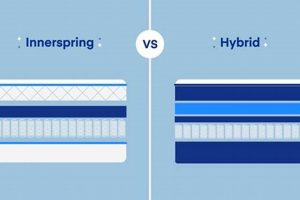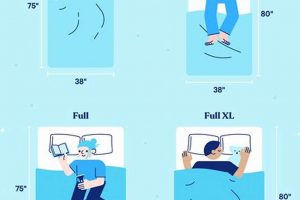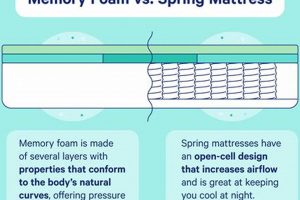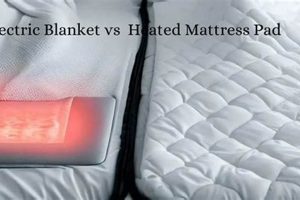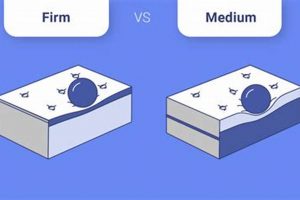The core distinction lies in construction and materials. One option utilizes exclusively foam layers, often varying in density and composition (e.g., memory foam, latex foam) to provide support and contouring. The alternative integrates a coil support system with layers of foam, latex, or other materials for a balanced feel. The former offers potential for pressure relief and motion isolation, while the latter can deliver enhanced support, bounce, and airflow.
Understanding the characteristics of each type is crucial for informed consumer decisions, impacting sleep quality and long-term comfort. The benefits extend to improved spinal alignment, reduced partner disturbance, and potentially alleviated pressure points. Historically, innerspring mattresses were the dominant choice; however, advancements in foam technology and hybrid designs offer diverse alternatives that address specific sleep preferences and needs.
A detailed examination of their construction, performance characteristics, and suitability for different sleeping styles will follow. Considerations such as temperature regulation, durability, and cost will also be addressed to facilitate a comprehensive understanding.
Considerations for Mattress Selection
The following are important considerations when evaluating different mattress constructions to ensure optimal sleep quality and comfort.
Tip 1: Assess Sleep Style. Side sleepers generally benefit from enhanced pressure relief, which may be better achieved with thicker foam layers. Back and stomach sleepers often require firmer support to maintain spinal alignment, potentially favoring hybrid models with robust coil systems.
Tip 2: Evaluate Temperature Regulation. All-foam mattresses, particularly those with high-density memory foam, can sometimes retain heat. Hybrids, with their coil layers, tend to promote better airflow and reduce heat buildup. Consider materials like gel-infused foam or breathable covers to mitigate heat retention.
Tip 3: Examine Edge Support. Individuals who sleep near the edge of the bed or require assistance getting in and out should prioritize strong edge support. Hybrid models typically offer better edge support due to their coil perimeter, whereas foam mattresses may exhibit more compression.
Tip 4: Determine Motion Isolation Needs. If sharing a bed, motion isolation is crucial to minimize partner disturbance. Foam mattresses excel at absorbing motion transfer, while hybrids may transmit more movement depending on the coil system and foam layer composition.
Tip 5: Analyze Durability and Longevity. The lifespan of a mattress depends on material quality and construction. High-density foams and well-constructed coil systems generally contribute to increased durability. Research warranty information and customer reviews to gauge long-term performance.
Tip 6: Research Material Composition and Certifications. Look for mattresses with CertiPUR-US certified foams to ensure low VOC emissions and absence of harmful chemicals. Consider natural latex options for enhanced breathability and hypoallergenic properties.
Tip 7: Understand Firmness Preferences. Firmness is subjective but crucial for comfort. Consider utilizing online resources or in-store trials to determine the preferred firmness level based on body weight, sleep position, and personal preferences.
Careful consideration of these factors will contribute to a well-informed decision, leading to a mattress that meets individual needs and promotes restorative sleep.
The subsequent sections will delve into specific brands and models, providing comparative analysis to aid in the selection process.
1. Motion Isolation
Motion isolation, referring to the ability of a mattress to absorb movement and prevent its transfer across the sleeping surface, represents a significant point of differentiation between foam and hybrid mattresses. The all-foam construction inherently possesses superior motion isolation properties. This stems from the material’s density and ability to dampen vibrations. Consequently, when one partner moves during sleep, the disturbance felt by the other is minimized. Consider, for instance, two individuals of differing sleep patterns sharing a full-foam mattress; the lighter sleeper is less likely to be awakened by the movements of the heavier sleeper compared to sleeping on a traditional innerspring or hybrid option.
In contrast, hybrid mattresses, which combine a coil support system with layers of foam, typically exhibit less effective motion isolation. The interconnected coils, while providing robust support and bounce, can transmit movement more readily across the mattress surface. The extent of motion transfer in a hybrid design is influenced by the type of coil system (e.g., individually pocketed coils versus interconnected coils), the thickness and density of the foam layers, and the overall construction. Therefore, a hybrid mattress with individually wrapped coils and thicker foam layers may offer improved motion isolation compared to a hybrid with traditional interconnected coils and thinner comfort layers. A practical application of this knowledge is when choosing a mattress for couples with very different sleep schedules.
Ultimately, understanding the relationship between construction materials and motion isolation is crucial for consumers prioritizing undisturbed sleep. While hybrid mattresses offer benefits such as enhanced support and airflow, all-foam options generally excel in minimizing motion transfer. The choice hinges on individual needs and preferences, recognizing that no single construction offers a universally superior solution for all sleep scenarios. Further research into specific models and their construction details is recommended to make an informed purchasing decision.
2. Spinal Alignment
Maintaining proper spinal alignment during sleep is crucial for minimizing back pain and promoting overall musculoskeletal health. The suitability of a mattress in achieving this alignment is directly influenced by its construction, specifically distinguishing characteristics within foam and hybrid designs.
- Contouring and Support Distribution
Foam mattresses, particularly those incorporating memory foam, excel at conforming to the body’s contours. This contouring allows for even weight distribution, reducing pressure points and supporting the natural curvature of the spine. For side sleepers, this can be particularly beneficial, as the mattress can accommodate the shoulders and hips without causing spinal misalignment. However, insufficient support in the foam core can lead to sagging, compromising spinal alignment over time, particularly for heavier individuals. Hybrid mattresses, conversely, utilize a coil support system in conjunction with foam layers. The coil system provides a more uniform and resilient support base, potentially preventing sagging and maintaining spinal alignment for a broader range of body types. The type of coil (e.g., pocketed coils versus interconnected coils) also impacts the degree of contouring and support, with pocketed coils offering more individualized support.
- Firmness and Sleeping Position
The optimal mattress firmness for spinal alignment varies according to sleeping position. Back sleepers generally require a medium-firm mattress to support the natural curve of the lower back. A mattress that is too soft will allow the hips to sink, leading to spinal misalignment, while one that is too firm will fail to provide adequate support for the lumbar region. Stomach sleepers typically require a firmer mattress to prevent excessive sinking of the midsection, which can strain the lower back and neck. Side sleepers often benefit from a softer mattress that allows the shoulders and hips to sink in, maintaining spinal alignment. The firmness of both foam and hybrid mattresses can be adjusted through varying the density and thickness of the foam layers or the coil gauge and configuration, allowing for tailored support based on sleeping position.
- Zoned Support Systems
Some mattresses, both foam and hybrid, incorporate zoned support systems. These systems utilize different densities of foam or coil arrangements in specific areas of the mattress to provide targeted support to different regions of the body. For example, the lumbar region may receive firmer support than the shoulder region, promoting spinal alignment. Zoned support can be particularly beneficial for individuals with pre-existing back pain or those who require more personalized support. The effectiveness of zoned support systems depends on the accuracy of the zoning and its alignment with the sleeper’s body.
- Long-Term Performance and Sagging Prevention
The long-term performance of a mattress significantly impacts its ability to maintain spinal alignment. Over time, mattresses can sag or develop impressions, leading to uneven support and spinal misalignment. Hybrid mattresses, with their coil support systems, often exhibit greater resistance to sagging compared to all-foam mattresses. However, the quality of the materials used in both foam and hybrid mattresses plays a crucial role in their long-term performance. High-density foams and durable coil systems contribute to greater longevity and sustained spinal support.
In conclusion, the choice between a foam mattress and a hybrid mattress for optimal spinal alignment depends on individual factors such as body weight, sleeping position, and personal preferences. Careful consideration of the mattress’s contouring ability, firmness level, zoned support system (if applicable), and long-term performance is essential to ensure proper spinal alignment and prevent back pain.
3. Temperature Regulation
Temperature regulation constitutes a critical factor in mattress selection, influencing sleep quality and overall comfort. The construction and materials of both foam and hybrid mattresses significantly impact their ability to dissipate heat and maintain a comfortable sleeping temperature. All-foam mattresses, particularly those employing high-density memory foam, inherently possess a greater tendency to retain heat. The closed-cell structure of memory foam restricts airflow, impeding the dissipation of body heat. This can lead to a sensation of sleeping “hot,” potentially disrupting sleep cycles and causing discomfort. Individuals residing in warmer climates or those prone to night sweats may find this characteristic particularly problematic.
Hybrid mattresses, in contrast, often exhibit superior temperature regulation capabilities due to their coil support system. The open structure of the coils allows for greater airflow throughout the mattress core, facilitating heat dissipation and reducing the accumulation of moisture. Furthermore, the inclusion of breathable materials such as natural latex or open-cell foam in the comfort layers can further enhance airflow and promote a cooler sleeping surface. For instance, a hybrid mattress incorporating a pocketed coil system and a latex comfort layer would generally provide better temperature regulation than an all-foam mattress constructed solely of high-density memory foam. Some manufacturers also incorporate phase-change materials (PCMs) into the mattress cover or foam layers to actively regulate temperature. PCMs absorb and release heat as needed, helping to maintain a consistent sleeping temperature throughout the night.
The practical implications of temperature regulation are significant for sleep quality. Maintaining a consistent and comfortable sleeping temperature minimizes sleep disturbances and promotes deeper, more restorative sleep. While all-foam mattresses may offer advantages in terms of pressure relief and motion isolation, their potential for heat retention should be carefully considered, particularly for individuals sensitive to temperature fluctuations. Hybrid mattresses, with their enhanced airflow and potential for incorporating cooling materials, represent a viable alternative for those prioritizing temperature regulation. Ultimately, the optimal choice depends on individual needs, preferences, and environmental factors. Understanding the interplay between mattress construction, materials, and temperature regulation is crucial for making an informed decision and achieving a comfortable and restful sleep experience.
4. Edge Support
Edge support, the structural reinforcement along a mattress’s perimeter, plays a crucial role in usability and perceived comfort. It directly impacts the usable sleeping surface, ease of ingress and egress, and overall mattress longevity. The construction differences inherent in foam and hybrid designs significantly influence their respective edge support capabilities.
- Foam Encased Edges
Some foam mattresses incorporate denser foam encasements around their perimeter to improve edge support. This reinforced edge provides a more stable surface for sitting or sleeping near the edge of the bed, preventing excessive compression and roll-off. However, even with foam encasements, all-foam mattresses generally exhibit less robust edge support compared to hybrid models. For instance, an individual sitting on the edge of an all-foam mattress may experience significant compression and a feeling of instability, particularly with softer foam densities. In contrast, the same individual sitting on a hybrid mattress with reinforced edges is likely to experience greater support and stability.
- Coil Perimeter Systems
Hybrid mattresses often utilize a coil perimeter system, where the coils along the edge of the mattress are either thicker gauge or encased in foam. This provides a more rigid and supportive edge, minimizing compression and maximizing the usable sleeping surface. The coil perimeter system works in conjunction with the foam layers to distribute weight evenly and prevent sagging over time. A practical example of this is couples sharing a queen-sized bed; strong edge support ensures both partners can utilize the full width of the mattress without feeling like they are going to roll off, maximizing usable space and comfort.
- Impact on Usable Surface Area
Edge support directly correlates with the usable sleeping surface of a mattress. Mattresses with weak edge support tend to compress significantly near the perimeter, effectively reducing the usable area. This is particularly relevant for individuals who share a bed or prefer to sleep near the edge. A mattress with strong edge support provides a more consistent and reliable sleeping surface from edge to edge, maximizing comfort and preventing the sensation of being confined to the center of the bed. Weak edge support could result in one party rolling to the center during sleep, even without conscious intentions.
- Durability Considerations
Consistent compression along the edges of a mattress can accelerate wear and tear, particularly in all-foam models without reinforced edges. Over time, the foam can lose its resilience and begin to sag, further compromising edge support and overall mattress performance. Hybrid mattresses, with their coil perimeter systems, typically exhibit greater resistance to edge sagging, contributing to increased longevity. The presence of robust edge support indicates the mattress is built to withstand regular use and maintain its structural integrity over time.
The level of edge support provided by a mattress is a key factor to consider when evaluating foam versus hybrid constructions. Hybrid mattresses generally offer superior edge support due to their coil perimeter systems, while foam mattresses may require foam encasements to improve stability. The optimal choice depends on individual needs and preferences, particularly for those who share a bed, sleep near the edge, or prioritize long-term durability. Evaluating edge support is essential in making a well-informed decision.
5. Pressure Relief
Pressure relief, defined as the ability of a mattress to minimize concentrated force on specific areas of the body, constitutes a crucial aspect of sleep comfort and musculoskeletal health. The inherent material properties and construction techniques employed in foam and hybrid mattresses significantly influence their respective pressure-relieving capabilities. Foam mattresses, particularly those incorporating viscoelastic memory foam, demonstrate superior contouring capabilities, conforming closely to the body’s shape and distributing weight more evenly. This reduces pressure on prominent contact points such as hips, shoulders, and knees. For individuals with conditions like arthritis or fibromyalgia, this characteristic can provide substantial pain mitigation. Conversely, hybrid mattresses, while offering support through their coil systems, may not exhibit the same degree of conforming ability, potentially leading to localized pressure build-up in certain areas.
The effectiveness of pressure relief in both mattress types is also contingent upon the density and thickness of the comfort layers. A thicker layer of high-density memory foam will generally provide more effective pressure relief than a thinner layer of lower-density foam. In hybrid mattresses, the type and arrangement of coils, in addition to the composition of the comfort layers, contribute to the overall pressure relief. Individually pocketed coils, for example, offer more localized support and contouring compared to interconnected coil systems, thereby enhancing pressure relief. Real-world examples illustrate this: a side sleeper on a high-quality foam mattress may experience significant reduction in shoulder and hip pain, while a back sleeper on a hybrid mattress with poorly designed comfort layers may experience pressure points in the lumbar region.
In summary, the level of pressure relief provided by a mattress hinges on its construction and material composition, with foam mattresses typically excelling in contouring and weight distribution, and hybrid mattresses requiring careful design to achieve comparable pressure relief. An understanding of these principles facilitates informed consumer choices, allowing individuals to select a mattress that effectively mitigates pressure points and promotes restful, pain-free sleep. The challenge remains in balancing pressure relief with adequate support, ensuring that the mattress conforms to the body without compromising spinal alignment.
Frequently Asked Questions
The following addresses common inquiries regarding the selection and performance characteristics of mattresses, specifically focusing on differentiating factors.
Question 1: Which mattress type exhibits superior motion isolation capabilities?
Foam mattresses, owing to their inherent material density and viscoelastic properties, typically demonstrate better motion isolation than hybrid models. This is due to the material’s ability to absorb and dampen vibrations, minimizing disturbance to a sleeping partner.
Question 2: Which mattress construction generally offers better temperature regulation?
Hybrid mattresses, incorporating coil support systems that promote airflow, often exhibit superior temperature regulation compared to all-foam designs. The open structure of the coils facilitates heat dissipation and reduces the accumulation of moisture.
Question 3: Which mattress type typically provides better edge support?
Hybrid mattresses, particularly those with reinforced coil perimeters, tend to offer more robust edge support. The firmer edge prevents sagging and maximizes the usable sleeping surface. However, foam mattresses with encased edges can provide acceptable levels of edge support as well.
Question 4: Which mattress is generally more suitable for individuals with back pain?
The suitability of a mattress for individuals with back pain is highly subjective and depends on the specific nature of the condition and preferred sleeping position. Both foam and hybrid mattresses can provide adequate support and pressure relief, but careful consideration of firmness and support characteristics is essential.
Question 5: Which mattress construction has a longer expected lifespan?
The lifespan of a mattress depends on material quality and construction. High-density foams and well-constructed coil systems typically contribute to increased durability. Hybrid mattresses can sometimes offer longer lifespans due to coil support systems.
Question 6: Are foam mattresses inherently more expensive than hybrid mattresses, or vice versa?
Pricing varies widely for both foam and hybrid mattresses depending on factors such as material quality, brand recognition, and construction complexity. It is not possible to generalize which type is inherently more expensive; comparison of specific models is necessary.
Careful evaluation of individual needs and preferences, coupled with thorough research into specific models, is recommended to facilitate an informed purchasing decision.
The following section will delve into specific brand and model comparisons.
Foam Mattress vs Hybrid
The preceding exploration has illuminated key distinctions between “foam mattress vs hybrid.” All-foam constructions offer enhanced motion isolation and conforming pressure relief, while hybrid models typically provide superior temperature regulation and edge support due to their coil systems. The optimal choice depends on individual factors such as sleep style, body weight, and specific needs. Material quality, construction techniques, and design features significantly influence the performance and longevity of both types.
Ultimately, a well-informed decision necessitates careful consideration of individual preferences and a thorough examination of available options. Further research into specific models and their respective specifications is encouraged to ensure a satisfying and restorative sleep experience.


